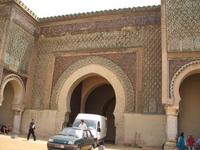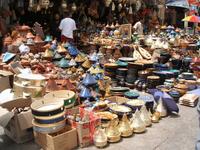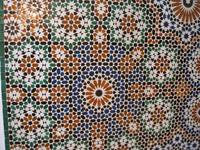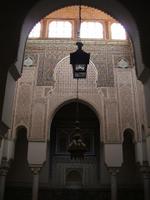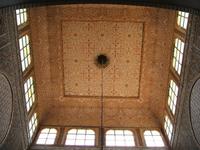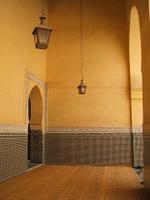Aug 17 – Arrival in Fes
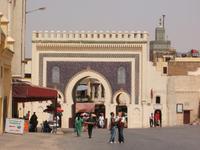 We actually had no hotel bookings for Fes because I thought this could be the city where we could experience sleeping on rooftop terraces. In the end, we were a little sketched out by the LP descriptions of the facilities at hostels offering terraces, so we decided to try calling for a room. We are in luck and actually land a 3-person room in a well-rated budget hotel due to some no-shows. It was by the famous gate called Bab Bou Jeloud pictured here.
We actually had no hotel bookings for Fes because I thought this could be the city where we could experience sleeping on rooftop terraces. In the end, we were a little sketched out by the LP descriptions of the facilities at hostels offering terraces, so we decided to try calling for a room. We are in luck and actually land a 3-person room in a well-rated budget hotel due to some no-shows. It was by the famous gate called Bab Bou Jeloud pictured here.Once at the hotel, we decide the first order of business is to pack up our washing and find a laundry facility (we have no clue what these will be like). On our way out, one of the hotel guys asks us where we our headed with our backpacks so full. Side note –all the hotel employees we saw were male, many of them were young (20-somethingish) and doubled as security, as they slept in rooms by the door of the hotel. We tell him we are looking for laundry. He tells us that we can have them done by the woman who comes to clean everyday. We look at each other… ok… The cost is 5Dh per item. Paying for laundry by item? Eeks… I pull out all the underwear and socks, leaving a total of 10 items, coming to a total of 50Dh or ~$7CAD. Still cheaper than the load I did in London.
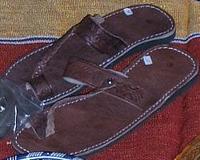 And so, backpack free, we explore the souqs of Fes as the night settles in. They are a maze of narrow cobblestoned streets, better designed for heat (i.e. shaded) than Meknes and just filled with people. A and I buy our first pair of simple leather sandals here from the cutest little boy (maybe 10-12 yrs old?) who tries to teach me Arabic phrases as A bargains. Shukran – thank you. Marhaba – welcome. Final price – 30Dh a pair.
And so, backpack free, we explore the souqs of Fes as the night settles in. They are a maze of narrow cobblestoned streets, better designed for heat (i.e. shaded) than Meknes and just filled with people. A and I buy our first pair of simple leather sandals here from the cutest little boy (maybe 10-12 yrs old?) who tries to teach me Arabic phrases as A bargains. Shukran – thank you. Marhaba – welcome. Final price – 30Dh a pair.Our next task of the night was to find dinner. Looking for a restaurant at night in tourist-districts of Morocco is a very different from choosing restaurants in Canada. At home, it is a pretty one-sided venture – flyers and advertisements aside, the restaurant plays a relatively passive role in getting customers in through their doors. In Morocco, this is far from the case.
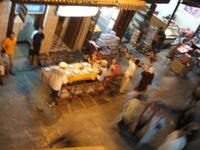 Here, servers double as hawkers (for lack of a better term). Mid-range priced tourist-oriented restaurants generally have large outdoor seating areas, nicer place-settings and menus in several languages. There are generally many in the same area, and differ little from one another in terms of service, price and fare. Thus, to ‘entice’ tourists to a particular restaurant, they have at least one man working the streets, shoving menus at every non-Moroccan looking person, asking “Are you hungry? Are you looking for a restaurant? Japon?” It takes some getting used to. When in a better mood, I would politely fend off proffered menus with a smile or “Thanks, but we’ve eaten”. When I began to get fed up with being seen as a walking money bag, I would walk past them as quickly as I could, making no eye contact.
Here, servers double as hawkers (for lack of a better term). Mid-range priced tourist-oriented restaurants generally have large outdoor seating areas, nicer place-settings and menus in several languages. There are generally many in the same area, and differ little from one another in terms of service, price and fare. Thus, to ‘entice’ tourists to a particular restaurant, they have at least one man working the streets, shoving menus at every non-Moroccan looking person, asking “Are you hungry? Are you looking for a restaurant? Japon?” It takes some getting used to. When in a better mood, I would politely fend off proffered menus with a smile or “Thanks, but we’ve eaten”. When I began to get fed up with being seen as a walking money bag, I would walk past them as quickly as I could, making no eye contact.This system would not be so bad if the hawkers were not also the servers. Since they are constantly working the streets in addition to the tables, once they have snared you, service is inattentive and slow. You can always tell the newbie-tourists. They always have this slightly stunned expression as they are taken by the hawker to their table. They look distrustful of their hawker, thinking they might have just been taken in there, but not completely certain what happened.
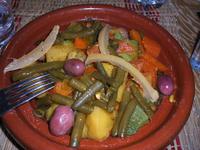 In Fez, there is a large cluster of restaurant close to Bab Bou Jeloud and we are still new to this aggressive canvassing by the waiters. Wanting to make our own decision, we finally chose to eat at the restaurant with the cool plates. The hariras were served lukewarm, but the tajines were excellent. This close-up shows a veggie tajine containing the Moroccan trademark flavours of olives and preserved lemon.
In Fez, there is a large cluster of restaurant close to Bab Bou Jeloud and we are still new to this aggressive canvassing by the waiters. Wanting to make our own decision, we finally chose to eat at the restaurant with the cool plates. The hariras were served lukewarm, but the tajines were excellent. This close-up shows a veggie tajine containing the Moroccan trademark flavours of olives and preserved lemon.Next - Aug 18 – In Fes
